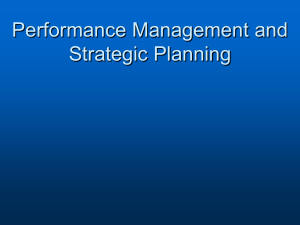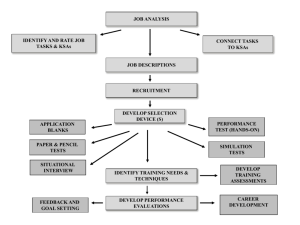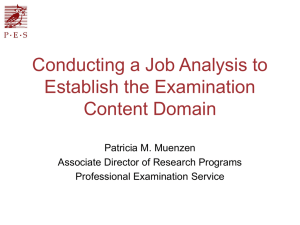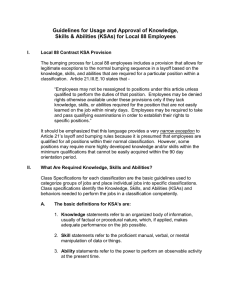Job Analysis Background Research
advertisement
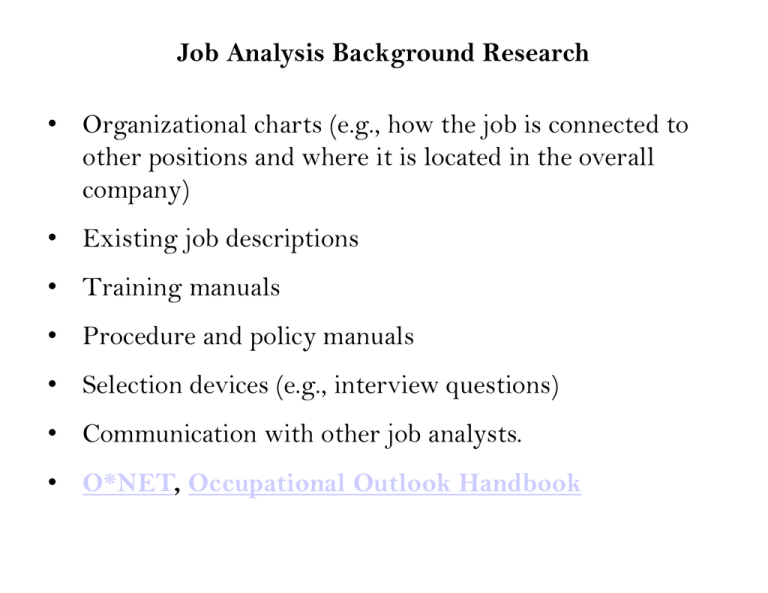
Job Analysis Background Research • Organizational charts (e.g., how the job is connected to other positions and where it is located in the overall company) • Existing job descriptions • Training manuals • Procedure and policy manuals • Selection devices (e.g., interview questions) • Communication with other job analysts. • O*NET, Occupational Outlook Handbook Initial Job Analysis Meeting • Have a senior member of management present (if possible) • Clearly state the purpose of a job analysis • Emphasize the benefits of performing a job analysis • Describe the process to be used (and time commitment) Example: JOB Task 1 Task 4 Task 2 Task 3 KSAs KSAs KSAs KSAs Also, rate both Tasks and KSAs on several factors and directly connect Tasks to KSAs • Answer any questions or concerns of SMEs • Summarize project activities/timeline Selection of Subject Matter Experts (SMEs) 1) On average, SMEs should have at least 6 months experience in the job category being analyzed (typically, it is recommended that temporary incumbants not be selected as SMEs) 2) SMEs should represent all of the incumbants in a given job category. They should reflect the job category in terms of demographics (e.g., gender, race), size, and composition. 3) Although the number of SMEs will vary due to the number of people in a given job category (& the avaliability of SMEs) in job categories consisting of less than 12 employees, at least 1/3 to 1/2 of the SMEs should be selected. 4) Usually, SMEs need to be above average employees. It’s best to avoid choosing ones with a consistently poor record of job performance. 5) SMEs need to be selected and notified well in advance of a job analysis session (about 2-3 weeks). 6) It is crucial for “top” or upper-level management to stress the importance of the job analysis effort to SME’s and to provide realistic incentives for their participation. Basic Task Statement Components 1) What is the action being performed? (using an action verb) • Make the verb as specific as possible. (More ambiguous words can be use if details are provide in the “how” section of the statement) • Use present tense, plural form of the verb (e.g., Assists, Supervises) 2) To whom/what is the action directed? (the object, or receiver, of the action verb) 3) How is the action performed? (e.g., use of certain procedures, equipment, tools). The “how” is arguably the most crucial part of the task statement in that it directly relates to KSAs. It is often introduced with the word “by” and typically consists of specific examples of representative list of procedures, equipment, tools, .. 4) Why is the action being performed? (the purpose of the action). Often, it is preceded by words such as “in order to” or “so as to.” Be careful not to confuse the “why’ part of the statement with the “what” section Example: (What?) Ensures that equipment is working properly by performing a variety of measurements ... (Why?) ... in order to ensure that equipment is working properly Basic Task Statement: An Example Task Statements (cont.) For a task statements to be adequate they should: • Include information on all the components in the above “formula” (What?, To Whom/What?, How?, Why?) • Be easy to read and understand (e.g., can a person who is unfamiliar with the job fully understand it?) • Describe all important job tasks or those which represent a substantial amount of time. Task statements should not be written for minor or incidental work activities such as “makes coffee” or “opens tool box”) Writing Preliminary Task Statements Some examples: ~ Monitors parts, equipment, and systems ~ Reviews technical documents ~ Troubleshoots equipment malfunctions Verification/Feedback on tentative task statements (via an interview or e-mail) ~ Are the statements accurate and clear? ~ Is the terminology appropriate and up-to-date? ~ Have any major tasks been omitted? ~ Are some of the tasks redundant; can they be combined? • Typically, 10 to 16 job task statements are sufficient for describing a job Sample Preliminary KSA Statements • Knowledge of heat conservation principles • Knowledge of electrical principles • Knowledge of mathematics • Skill in cutting a board to within 1-16” inch of required measurement • Ability to perform physical activity • Ability to communicate Knowledge, Skills, & Abilities Knowledge statements: Possession of certain information (e.g., facts, procedures, techniques) relevant to the performance of a task or set of tasks • Avoid “modifiers” within a knowledge statement such as “basic,” “extensive,” “detailed,” considerable” • Having a given knowledge does not guarantee competence in its application Skill statements: An individual’s level of proficiency or competency in performing a certain task which has specific measurable parameters of performance. Ability statements: The competence to perform a action or behavior at the time in question (not the potential or aptitude to perform) • Avoid “modifiers” (e.g., extensive ability to properly measure …) Examples of Modifiers to Avoid • Detailed knowledge of membrane manufacturing procedures, GMP, and SPC. • Basic knowledge of computer software programs (e.g., Word, Excel, Access) Prerequisite Knowledge vs. Ability Statements Is K-5 really needed? How about the need for both K2, K3, K4 AND A-1, A-2, A-3 Knowledge, Skills, & Abilities (cont.) • KSAs should be listed as a knowledge, skill or ability but not as more than one. For example, it is NOT necessary to list both “Ability to use basic arithmetic to calculate flow of current through an electric circuit” and “Knowledge of arithmetic to calculate…” • Frequently it is difficult to distinguish between skills and abilities. For purposes of preparing KSA statements, it is not absolutely essential that a statement is correctly classified as a skill or ability • Specific statements are preferable to broad, general ones that lack clarity as to what actual KSAs are required. For instance, if a statement of “knowledge of mathematics” is proposed, it may be necessary to ask “what kind?,” to what extent?,” “to solve what type of problems? ….. Knowledge, Skills, & Abilities (cont.) • Avoid rephrasing a job task as a knowledge, skill or ability. For example, “inspects equipment” should not be accompanied by the “ability to inspect equipment” • It is recommended to systematically go through each job task statement and list any KSAs needed to perform that specific work activity. Generally, each job task will have at least one KSA associated with it, some tasks may have multiple KSAs. A KSA may apply to multiple job tasks Avoid Use of Multiple Verbs Records and reviews various reports and information (e.g., production, downtime, scrap data) entered by operators during production runs daily and takes corrective action when necessary by using various computer programs and databases (e.g., QA, Scrap Database, Downtime Database), identifying root cause(s) of problem and/or assigning action item(s) to appropriate personnel in order to ensure accurate documentation of information and reduce downtime and scrap. Writes, signs, and follows up on Maintenance and Engineering work orders by using computer-based programs (e.g., EtQ) and contacting relevant departments (via radio, phone, or in-person) in order to maintain, improve, and/or repair equipment. Trains, monitors, and documents the performance of new employees by teaching the operation of equipment using hands-on method, training documents (e.g., SWIs, MIs) and training records to assure employees can successfully perform job-relevant duties.

